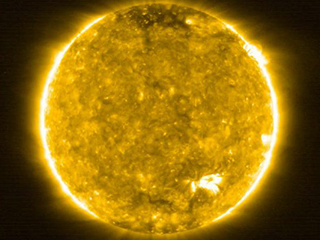Overview
The Sun—the heart of our solar system—is a yellow dwarf star, a hot ball of glowing gases.
Its gravity holds the solar system together, keeping everything from the biggest planets to the smallest particles of debris in its orbit. Electric currents in the Sun generate a magnetic field that is carried out through the solar system by the solar wind—a stream of electrically charged gas blowing outward from the Sun in all directions.
Sun In Depth
The Sun is a yellow dwarf star, a hot ball of glowing gases at the heart of our solar system. Its gravity holds the solar system together, keeping everything – from the biggest planets to the smallest particles of debris – in its orbit. The connection and interactions between the Sun and Earth drive the seasons, ocean currents, weather, climate, radiation belts and auroras. Though it is special to us, there are billions of stars like our Sun scattered across the Milky Way galaxy.
The Sun has many names in many cultures. The Latin word for Sun is “sol,” which is the main adjective for all things Sun-related: solar.
Sun's Temperature
The temperature at the surface of the Sun is about 10,000 Fahrenheit (5,600 Celsius). The temperature rises from the surface of the Sun inward towards the very hot center of the Sun where it reaches about 27,000,000 Fahrenheit (15,000,000 Celsius). The temperature of the Sun also rises from the surface outward into the Solar atmosphere. The uppermost layer of the Solar atmosphere, called the corona, reaches temperatures of millions of degrees. The corona is the bright halo of light that can be seen during a total Solar eclipse.

Size and Distance
With a radius of 432,168.6 miles (695,508 kilometers), our Sun is not an especially large star—many are several times bigger—but it is still far more massive than our home planet: 332,946 Earths match the mass of the Sun. The Sun’s volume would need 1.3 million Earths to fill it.
The Sun is 93 million miles (150 million kilometers) from Earth. Its nearest stellar neighbor is the Alpha Centauri triple star system: Proxima Centauri is 4.24 light years away, and Alpha Centauri A and B—two stars orbiting each other—are 4.37 light years away. A light year is the distance light travels in one year, which is equal to 5,878,499,810,000 miles or 9,460,528,400,000 kilometers.
Orbit Rotation
The Sun, and everything that orbits it, is located in the Milky Way galaxy. More specifically, our Sun is in a spiral arm called the Orion Spur that extends outward from the Sagittarius arm. From there, the Sun orbits the center of the Milky Way Galaxy, bringing the planets, asteroids, comets and other objects along with it. Our solar system is moving with an average velocity of 450,000 miles per hour (720,000 kilometers per hour). But even at this speed, it takes us about 230 million years to make one complete orbit around the Milky Way.
The Sun rotates as it orbits the center of the Milky Way. Its spin has an axial tilt of 7.25 degrees with respect to the plane of the planets’ orbits. Since the Sun is not a solid body, different parts of the Sun rotate at different rates. At the equator, the Sun spins around once about every 25 days, but at its poles the Sun rotates once on its axis every 36 Earth days.
Structure
The Sun, like others stars, is a ball of gas. In terms of the number of atoms, it is made of 91.0% hydrogen and 8.9% helium. By mass, the Sun is about 70.6% hydrogen and 27.4% helium.
The Sun's enormous mass is held together by gravitational attraction, producing immense pressure and temperature at its core. The Sun has six regions: the core, the radiative zone, and the convective zone in the interior; the visible surface, called the photosphere; the chromosphere; and the outermost region, the corona.
Formation
The Sun and the rest of the solar system formed from a giant, rotating cloud of gas and dust called a solar nebula about 4.5 billion years ago. As the nebula collapsed because of its overwhelming gravity, it spun faster and flattened into a disk. Most of the material was pulled toward the center to form our Sun, which accounts for 99.8% of the mass of the entire solar system.

Kid-Friendly Sun
The Sun is a star. There are lots of stars, but the Sun is the closest one to Earth. It is the center of our solar system.
The Sun is a hot ball of glowing gases. It keeps our planet warm enough for living things to thrive. It gives us light so we can see.
Eight planets move around the Sun. We call that an orbit. The planets are: Mercury, Venus, Earth, Mars, Jupiter, Saturn, Uranus and Neptune. Lots of smaller worlds orbit the Sun. Pluto is a dwarf planet beyond Neptune. There are many asteroids and comets that go around the Sun, too.
Surface
The surface of the Sun, the photosphere, is a 300-mile-thick (500-kilometer-thick) region, from which most of the Sun's radiation escapes outward. This is not a solid surface like the surfaces of planets. Instead, this is the outer layer of the gassy star.
We see radiation from the photosphere as sunlight when it reaches Earth about eight minutes after it leaves the Sun. The temperature of the photosphere is about 10,000 degrees Fahrenheit (5,500 degrees Celsius).
Atmosphere
Above the photosphere lie the tenuous chromosphere and the corona (crown), which make up the thin solar atmosphere. This is where we see features such as sunspots and solar flares
Magnetosphere
The electric currents in the Sun generate a complex magnetic field that extends out into space to form the interplanetary magnetic field. The volume of space controlled by the Sun's magnetic field is called the heliosphere.
Moon
The Sun and other stars don't have moons; instead, they have planets and their moons, along with asteroids, comets, and other objects.
Potential for Life
The Sun itself is not a good place for living things, with its hot, energetic mix of gases and plasma. But the Sun has made life on Earth possible, providing warmth as well as energy that organisms like plants use to form the basis of many food chains.